Key Takeaways:
-
With the massive savings afforded by converting to an augmented intelligence solution workflow, laboratories can manage things like prior authorizations and denials much more efficiently.
-
An augmented intelligence system like this would be supported by experienced specialists to process emergent or complex prior authorizations or denials and provide a complete end-to-end solution.
-
The answer is a deployed AI-driven solution that utilizes machine learning capabilities and predictive analytics to remain current on the various changing insurance payer guidelines.
While 2020 and 2021 have certainly taken an unexpected turn making financial projections and budget expectations obsolete, it has also brought a time of reevaluation and reflection in an industry that runs at hyper-speed 24/7. With COVID-19 impacting the patient census in hospitals and creating wildly fluctuating patterns in onsite care in provider practices and outpatient facilities, ancillary services like laboratory testing have had the opportunity to reevaluate the long-term efficiencies brought by augmented intelligence automation solutions.
With the financial impact of COVID-19 still up for grabs and laboratories struggling with serious cash flow issues, the one area in capital expenditures that is not being reallocated or revamped is IT upgrades. Laboratories, whether inpatient or outpatient, understand that AI enhancements are key to improving overall revenue as the reimbursement picture continues to tighten at a now-accelerated pace.
How Can Augmented Intelligence Improve Laboratory Revenue?
There is a tremendous opportunity to review physically cumbersome, administratively inefficient, and fiscally ineffectual systems. With the massive savings afforded by converting to a tech-enabled service solution workflow, laboratories can manage things like prior authorizations and denials much more efficiently.
3 Areas That Easily Adapt to AI Functions
Let’s look at three areas within the healthcare payment lifecycle that lend themselves to automation and AI-driven solutions.
Patient Access
-
Prior Authorizations — For laboratories, molecular and genetic diagnostics are the rising stars becoming more common with new and better tests being developed every day. Today, molecular and genetic testing are responsible for an estimated $8.7 billion in laboratory revenue and is expected to grow to $12.9 billion by 2024.
With the increased usage will most likely come increases in prior authorization requests from insurance payers, but laboratories are struggling with lost revenue from missing prior authorizations from referring providers, retro prior auths being denied, and inpatient/emergent testing needing initial prior auths.
What if there was a >98+% accurate solution, available for processing and follow-ups 24/7, and by its digital nature, alleviated burdensome administrative staff hours?
The answer is a deployed AI-driven prior authorization solution that utilizes machine learning capabilities and predictive analytics to remain current on the various changing insurance payer guidelines. Additionally, a system like this would be supported by experienced specialists to process emergent or complex prior authorizations, as required – all to keep the system running smoothly and providing a complete end-to-end solution.
Revenue Cycle Management
-
A/R Optimization and Denials Management — Like prior authorizations and patient access, AI-driven automation can make quick work of managing the overall A/R process, especially the claim denial workflow. Denials are often left to languish until someone has time to tend to them, or worse, shelved completely.
The Medical Group Management Association (MGMA) reports that industry-wide 50-60% of denials are never worked due to lack of knowledge or time. As margins tighten, labs no longer have the luxury of ignoring denied claims that jeopardize the bottom-line revenue.
By utilizing AI and machine learning technology, labs can navigate a plethora of insurance clearinghouses with constantly updating rules and regulations to ensure their efforts are current and up-to-date, claims are resubmitted timely, and money collected when due.
-
Insurance Discovery — The ability to bring AI capacity to self-pay A/Rs and outstanding accounts to search vast insurance clearinghouses for undisclosed insurance coverage sounds like something in the distant future.
Available now, this type of digital technology integrates with your LIS/EHR/EMR systems to check and verify unknown insurance coverage, verify benefits, and resubmit unpaid claims to the new insurance carrier. With up to 10% of uncollectible accounts being recoverable, this new technique takes a significant bite out of write-offs and moves them to the bottom-line.
Salvaging 2021 is on top of everyone’s mind right now. Volume declines have hit all types of labs with cash flow down by over $5 billion in two months. With a renewed focus on COVID-19 and the Delta Variant, there has been a complete breakdown of high-margin tests that drive bottom-line revenue.
Now may be the time to integrate new technologies to be better prepared to fight another day.
Contact us to schedule a demo about augmented intelligence solutions for patient access and RCM.
